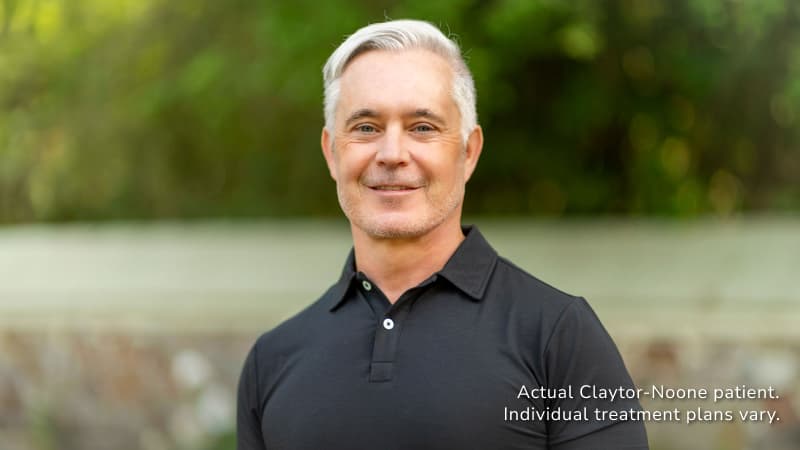Men’s Liposuction (Lipoplasty for Men)
Permanently remove excess fat on the body & lower face to improve health & boost self-confidence.For men in the Bryn Mawr/Main Line area of Philadelphia, we know that stubborn, unwanted body fat can interfere with your quality of life. If you’ve been dieting and hitting the gym but still aren’t seeing the results you want, men’s liposuction can help you shed those unwanted pounds to reveal your natural, hard-earned muscle definition.
What is liposuction for men?
Liposuction is a minimally invasive surgical procedure that strategically removes fat in the body and lower face. By eliminating pesky fat deposits, liposuction can also tone and contour the body to provide a slimmer, more masculine physique. Liposuction can be used to treat the following areas:
- Abdomen
- Back & flanks (“love handles”)
- Upper arms
- Buttocks
- Calves & ankles
- Chest & back
- Hips & thighs
- Chin & neck
How is liposuction for men unique?
Unlike liposuction for women, Dr. Claytor performs men’s liposuction to contour areas specific to the male body to produce a classically-attractive figure (think: narrow waist, six-pack, and a firm, flat chest). Dr. Claytor understands that a man’s anatomy and aesthetic desires are unique, and he has extensive experience helping men regain a firmer, more defined body.
Dr. R. Brannon Claytor
Dr. Claytor is board certified by the American Board of Plastic Surgery and holds over 20 years of experience as a cosmetic plastic surgeon. An innovator and teacher in the field of plastic surgery, he uses advanced techniques like the drain-free tummy tuck and deep plane facelift to streamline recovery and provide natural-looking, durable results.



What are the benefits of male liposuction?
If you’re a man carrying excess weight, liposuction can:
- Improve your overall health and stamina.
- Increase your confidence. (Going shirtless becomes an opportunity rather than something to dread.)
- Make you look more distinguished. (Less weight will make you appear taller.)
- Motivate you to maintain your enhanced physique since you’ll be able to see results from diet and exercise more easily.
- Make wearing clothing more comfortable.
How does liposuction work?
Liposuction is a safe and proven procedure to permanently reduce fat cells between the skin and muscle in a specific area of the body. Watch Dr. Claytor’s 3-D visualization of liposuction performed during a tummy tuck below to learn more.
Video Transcript
I’m Dr. Brannon Claytor, board-certified plastic surgeon. I’d like to talk to you about the tummy tuck operation with concomitant liposuction. Here the suction areas are marked on the abdomen to ensure and maximize abdominal contours and definition. The tumescent fluid is injected into the abdomen, and then the liposuction is performed. You can see here the fat being withdrawn, which is allowing for the skin to be contracted. The red and blue represent blood vessels. Suction area 4 is the abdominoplasty portion to be removed. The central area is dissected down to the rectus fascia; laterally, the scarpa’s fascia is left intact to allow for lymphatic drainage. The upper flap is elevated up to the level of the xiphoid. Additional liposuction of the upper flap is performed. Cross sectional analysis of this demonstrates reduction of the fat in this area with protection of the blood vessels to improve wound healing. The rectus diastasis is repaired with sutures. If the scarpa’s fascia is still full on the inferior aspect, additional liposuction can be performed to de-bulk this area and minimize the contours. The green areas represent the intact lymphatics that are left in scarpa’s fascia. Excess scarpa’s fascia is excised superiorly to improve abdominal contour. The flap is advanced to closure and the umbilicus is delivered and inset. This has been a demonstration of tummy tuck with concomitant liposuction. I’m Dr. Brannon Claytor, board-certified plastic surgeon. I hope you found this 3D animation helpful as you explore your options for abdominal rejuvenation.
Can I still gain fat after liposuction?
Your fat cells that have been treated with liposuction are gone forever, but you can still gain fat in your remaining fat cells, therefore it’s important to lead a healthy lifestyle following your treatment. Liposuction is not a weight loss solution, but rather a body sculpting procedure to help you slim and tone your appearance. Liposuction is also not effective at eliminating cellulite or tightening loose, sagging skin.
What is surgery & recovery like for men’s liposuction?
Dr. Claytor typically performs men’s liposuction as an outpatient procedure under general anesthesia in his Quad A-accredited surgical suite located near Bryn Mawr Hospital in Philadelphia. By making a small incision in the area you wish to treat, Dr. Claytor inserts a thin tube (called a cannula) connected to a vacuum to suction the fat from your body. Depending on the extent of your liposuction, the procedure typically lasts between 1 to 2 hours.
You can expect some mild pain, swelling, and bruising after the procedure, and won’t be able to do any heavy lifting or physical activity for about 5 to 7 days. Results from liposuction are immediate and will continue to improve as your swelling diminishes. Right after surgery, your body will already be slimmer and more defined, and your full results will begin to reveal themselves after about 4 months. You can enjoy the results of your liposuction treatment for as long as you maintain a healthy lifestyle.
- Key Benefits
- Glossary
- Improved contour: Liposuction removes stubborn fat deposits, sculpting and defining the body for a leaner, more athletic appearance.
- Quick recovery: Minimally invasive techniques often allow for faster healing and a swift return to daily activities compared to more extensive surgeries.
- Targeted fat removal: Efficient at targeting specific areas of the body where fat is hard to lose through diet and exercise alone.
Adipose Tissue: The medical term for fat within the body.
Anesthesia: Refers to drugs or substances that will cause loss of feeling or awareness, used to eliminate pain during the procedure.
Cannula: A thin tube that is used to remove fat during liposuction.
Compression Garment: Special clothing worn to reduce swelling after the surgery.
Contouring: The process of reshaping the body.
Lipoplasty: Another term for liposuction.
Suction-Assisted Lipectomy (SAL): A traditional method of liposuction.
Tumescent Technique: Involves injecting large amounts of medicated solution into the areas being treated.
VASER: An acronym for Vibration Amplification of Sound Energy at Resonance, a technology used to break down fat cells with ultrasound.
Seroma: An accumulation of serum within the body which may occur after surgery.
Hematoma: A collection of blood outside of a blood vessel.
Incision: The cut made in the skin to perform the procedure.
Post-Operative: The period following the surgery.
Pre-Operative: The period leading up to the surgery.
Recovery Time: The time it takes for a patient to heal and return to normal activities after surgery.
Invasive Procedure: Any medical procedure that enters the body, typically with instruments or devices.
Sedation: Administration of a sedative drug to calm or induce sleep in a patient.
Lipoatrophy: The localized loss of fat tissue.
Lipolysis: The breakdown of fats in the body.
Lipoedema: A chronic disorder characterized by symmetric enlargement of the legs due to deposits of fat beneath the skin.
Does liposuction cause scarring?
There is minimal scarring associated with men’s liposuction. Dr. Claytor takes the utmost care to minimize scarring by making very small incisions in inconspicuous locations hidden by the body’s natural folds.
What procedures can enhance my liposuction results?
While liposuction on its own is a powerful tool for helping men remove unwanted fat in the body and lower face, Dr. Claytor can combine liposuction with the following surgical procedures to further enhance your appearance:
- Dr. Claytor often performs liposuction as part of abdominoplasty, a.k.a. tummy tuck surgery, with an artistic eye for the male physique by firming and tightening the skin and muscles of the abdomen. During a tummy tuck, Dr. Claytor can also correct diastasis recti—the belly “pooch” that men often develop as they age.
- Liposuction is often performed as part of gynecomastia, or male breast reduction, surgery. By removing inflamed tissue and excess fat in the breasts, Dr. Claytor is able to reveal a broad, contoured chest for his male patients. Many men with gynecomastia only have a small amount of fat in the breasts that cause “man boobs,” and these patients can benefit from minimal liposuction.
- If your skin has good elasticity and tone, it will mold itself to your new contours easily after your liposuction treatment. However, the skin in areas that have been treated with liposuction may appear saggy and loose if your skin lacks elasticity or you have had a significant amount of fat removed. If you’re planning on having liposuction performed on your thighs, a thigh lift, a.k.a. thighplasty, can tighten the skin around the inner thighs to create tight, toned upper legs.
Why choose Dr. Claytor for your plastic surgeon?
Double Board-Certified for a high level of safety and precision
Chief of Plastic Surgery at Main Line Health, a top health system
Board Member of The Aesthetic Society, shaping the future of aesthetics
10x Philadelphia Magazine Top Doctor for exceptional patient care
Recognized as one of America’s Best Plastic Surgeons by Newsweek
Drain-free recovery expert for faster, more comfortable healing
Deep plane facelift innovator and global educator
Active researcher in surgical and non-surgical aesthetic advancements
Highly regarded for his surgical expertise and outcomes, as well as his dedicated follow-up care





Dr. R. Brannon Claytor is a board-certified plastic surgeon with over 20 years of experience serving the Bryn Mawr/Main Line area of Philadelphia. He has received numerous awards and recognitions, including Main Line Today’s Top Doctor of 2015. Contact our office online or call (610) 527-4833 to schedule your male liposuction consultation with Dr. Claytor today.
References »
Bellini E, Grieco MP, Raposio E. A journey through liposuction and liposculture: Review. Annals of Medicine and Surgery. 2017 Nov 6;24:53-60. doi: 10.1016/j.amsu.2017.10.024.
Yoshida S, Koshima I, Imai H, Roh S, Mese T, Uchiki T, Sasaki A, Nagamatsu S. Effect of Postoperative Compression Therapy on the Success of Liposuction in Patients with Advanced Lower Limb Lymphedema. Journal of Clinical Medicine. 2021 Oct 22;10(21):4852. doi: 10.3390/jcm10214852.
Shridharani SM, Broyles JM, Matarasso A. Liposuction devices: technology update. Medical devices (Auckland, NZ). 2014 Jul 21;7:241-51. doi: 10.2147/MDER.S47322.
Wu S, Coombs DM, Gurunian R. Liposuction: Concepts, safety, and techniques in body-contouring surgery. Cleveland Clinic Journal of Medicine. 2020 Jun;87(6):367-375. doi: 10.3949/ccjm.87a.19097.
Areas Served:

Medically reviewed by Dr. R. Brannon Claytor — Updated on Oct 28, 2024


